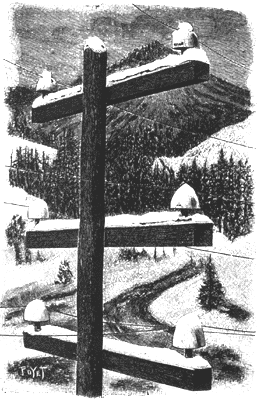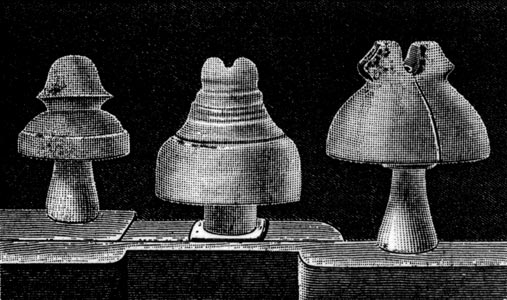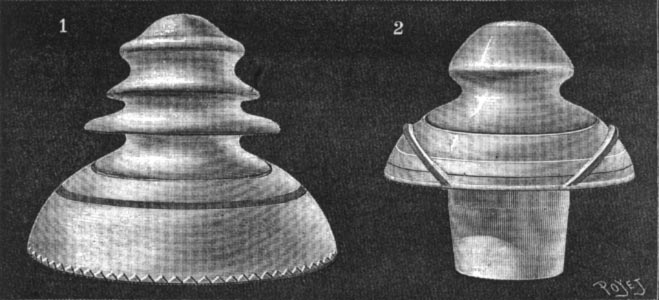[Trade Journal]
Publication: Scientific American Supplement
New York, NY, United States
vol. 49, no. 1253, p. 20087, col. 1-2
HIGH TENSIONS AND THE TRANSMISSION
OF ELECTRIC ENERGY.
SEVERAL of our subscribers, says La Nature, have asked us for some information as to how high a tension can now be reached for the transmission of electric energy. The question is an important one and has been the subject of much study since the publication by The Electrical World, in 1898, of a paper presented to the American Institute of Electrical Engineers, at Omaha, by Mr. Charles Scott, chief electrician of the Westinghouse Electric and Manufacturing Company.
 |
| Fig. 1. — Glass and Porcelain Insulators Fixed Upon Arms Attached to Poles. |
We shall endeavor to make a resume of this paper and give its conclusions.
In 1891, the Westinghouse Company made an installation of a transmission of motive force of 10,000 volts between San Bernardino and Pomona, in California. In the first place, it tried transformers, and afterward resolved to make some experiments on high tension upon insulators and lines. With insulators mounted upon wood and with an efficient difference of potential of 50,000 volts, the loss was about 8 watts per insulator. Very numerous experiments were made with nine wires, 60 feet in length, placed horizontally and parallel at a distance of 4 inches apart, and supplied by currents of a frequency of 60 and 185 periods per second. The losses were slight up to 20,000 volts, but afterward increased till they reached about 1,200 watts for 30,000 volts. The losses diminished rapidly in measure as the distance increased; and it was found that the loss for the distance of 4 inches and at 28,000 volts was the same as the loss for that of 16 inches and at 36,000 volts. It was likewise observed with the wires that starting from 20,000 volts, they commenced to become luminous and to hiss, and that the luminous sheath and the sound gradually increased, while the experimental hall became charged with ozone.
Some new experiments were afterward made between the central generating station at Ames, Colorado, and Gold King Mill, at a distance of about two and a quarter miles. A synchronous motor of 100 horse power was installed in the mill, and the energy was transmitted at the most varied differences of potential. The line, which was formed of iron wire, 0.156 of an inch in diameter, was fixed upon glass and porcelain insulators, carried upon 62 poles, each provided with three arms (Fig. 1), the highest of which was 26.25 feet above ground. Each arm carried two insulators of the same type; the upper arm, two large glass ones; the intermediate arm, two small glass ones;, and the lower arm, two large porcelain ones. Fig. 2 shows the details of the insulators tried.
| |||
| Fig. 2. — Insulators Tried With High Tension at Ames, Colorado. |
The experiments were made in December, 1895, with a tension of from 25,000 to 33,000 volts, now empty and now at the charge of 100 horse power mentioned above. In January, 1896, the tension was raised to 45,000 volts for seven days, and, at the end of the month of March, there were begun some experiments at 50,000 volts that lasted thirty-seven days in succession, and that were interrupted only by the damaging of a transformer by a stroke of lightning.
During these experiments, says the report, the climatic conditions were at times very unfavorable, since violent wind storms, clouds of dust. snow (sometimes wet), and rain occurred. At 50,000 volts the wires were plainly visible during the night; and at a distance of several hundred yards was heard the hissing characteristic of currents of a high tension. A few measurements were made at this time, and it was found that the losses were feeble below 45,000 volts, but rapidly increased beyond 50,000, and reached 16.4 kilowatts at 59,000.
| |||
| Fig. 3. — Types of Insulators. 1. Insulator Tried at Provo at 40,000 Volts. 2. Insulator Employed by the Colorado. |
Similar experiments were made at Pittsburg and Niagara, and the results obtained were the same.
Among the present high tension transmissions may be mentioned the installation at Provo, Utah, of the Telluride Power Transmission, which transmits a power of 500 kilowatts at an efficient difference of potential of 40,000 volts to a distance of 33 1/3 miles. Fig. 3 (No. 1) shows the type of insulator used by the Colorado Electric Power Company, which transmits power at 20,000 volts.
It is of interest to give, in a few words, the conclusions that the Americans have drawn from their experiments. Upon a high tension line, the losses by insulators are of slight consequence, and the losses by wires are feeble in climates in which the air is pure. In a transmission there is always a maximum tension that is the most economical. Porcelain and glass insulators have, both of them, their advantages and their disadvantages, which are comparable. It is estimated that the distance to which a given power can be economically transmitted is equal to about five times the efficient tension in kilowatts. The power to be transmitted is also limited to a given distance by reason of economy.
These experiments are truly important, and teach us that, in the present state of science, electric transmissions of energy can be made at 50,000 volts to distances of 180 miles.


